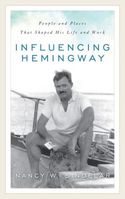
 Ernest Hemingway exuded a brand of masculinity and a philosophy of life that has been a fascination to both men and women. Men admired his adventures in World War I, the Spanish Civil War and World War II along with his legendary hunting and fishing expeditions. Women were charmed by his masculine self-confidence and good-natured story-telling. Marlene Dietrich called him “the most fascinating man I know” and said he “found time to do the things most men only dream about.” She was right. He courted life-threatening adventures, glamorous friends while writing articles, novels and short stories that captivated the world.
Ernest Hemingway exuded a brand of masculinity and a philosophy of life that has been a fascination to both men and women. Men admired his adventures in World War I, the Spanish Civil War and World War II along with his legendary hunting and fishing expeditions. Women were charmed by his masculine self-confidence and good-natured story-telling. Marlene Dietrich called him “the most fascinating man I know” and said he “found time to do the things most men only dream about.” She was right. He courted life-threatening adventures, glamorous friends while writing articles, novels and short stories that captivated the world.
As a former English teacher at Hemingway’s alma mater, Oak Park and River Forest High School, I first explored Hemingway’s high school years as a means of my engaging students in his novels. My students were quick to view Hemingway as a legendary author who led an action-filled life, but many felt that their own lives paled in comparison to his and that being in school was often “just boring.”
My students’ attitudes inspired me to do some research on Hemingway’s life as a high school student. I studied his yearbooks, his high school writing and even met some of his former teachers. Turns out young Hemingway was a good student, a high school athlete, editor of the school’s newspaper and contributor to the literary magazine. He also played the cello in the school’s orchestra and a participated in the school play. Together, my students and I learned that Hemingway was just as involved with life as a teenager as he was as an adult.
After accepting a contract to write a Hemingway biography, my research took me to Paris, where I found the apartments where he lived and the cafes where he ate, drank and wrote and to Chamby, Switzerland, where he skied. It was easy to see how a boy from suburban Oak Park, Illinois could be energized and transformed by the people, the food and the freedom of Paris during the 1920’s, and be equally thrilled with the opportunities to ski and sled in the mountains of Switzerland.
When Hemingway left Paris, he went to Key West, Florida, so I went there too and then, like Hemingway, on to Cuba. After only a few days in Havana, it was clear to me why Hemingway was attracted to Cuba. The people were charming, honest and friendly; the climate and culture were warm and exotic; and the island was surrounded by beautiful waters and opportunities for world-class fishing.
I had been asked to make a presentation at the 13th International Ernest Hemingway Colloquium and spoke about the people and places that influenced Hemingway from his birth to until he left Oak Park after graduation from high school. I told stories about the influences of his grandparents, parents and teachers and punctuated them with photos of his birthplace and boyhood homes, his summers in northern Michigan and his interests and scholarship while in high school. The presentation had no political bias, no particular prejudice about the writer or the legend and was silent regarding the impact of the author’s four wives and various extramarital relationships. It was the story of a boy and his family.
What became significant was the impact of Hemingway’s early years on the rest of his life. How a little boy, fishing with his father during summers spent in northern Michigan, developed a life-long love for the sea and sport fishing, and how his mother, who often has been viewed as a controlling shrew, could be viewed as caring woman who nurtured a life-long passion for fishing and the outdoors in her son.
As the Colloquium progressed, it became clear that the boy from Oak Park, Illinois grew not only to be a great writer, but a captivating and complex legend. Not only was he an iconic American author, but scholars from around the world claimed him as their own. Spending time in Cuba, seeing Hemingway’s house, his clothes, his boat, his typewriter and visiting his favorite bars and restaurants yielded a deeper understanding of how the people and events in his early life shaped his thinking and actions.
Finally, just as skiing and hunting drew Hemingway to Sun Valley, I too was attracted to the resort and the celebrity atmosphere of the Sun Valley Lodge and the skiing terrain of the Sawtooth Mountains. Though Hemingway ended his life’s journey in his house near Sun Valley, his writing, as well as his adventures, still captures the admiration of Hemingway aficionados around the world. Writing about his life has been a fascinating journey.
To comment on Nancy W. Sindelar’s blog please click here.


No Comments
Comments are closed.